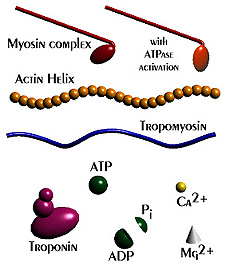
Back to Basics: Relax!
Biz blinds us with science! (Don’t worry, she explains.)
Follow the journey of a “somewhat ordinary” horse and rider pair as they strive for greatness.
Want to catch up on Biz’s past columns? Click the #BACK TO BASICS hashtag above.
Last week we talked about the importance of a round horse. This week we’re going to talk about how to begin initiating roundness in our horses by encouraging relaxation in the muscle groups that run over the top of the back and neck, but first, since I’m a nerd, and I believe it is fundamental to properly training a horse, let’s talk about how muscles work.
Nerdy crap to impress your friends (aka the “bio” in biomechanics):
Muscles are composed of several bundles of long, cylindrical, muscle cells. Each cell contains actin and myosin filaments. The myosin filaments look like a string of tiny hands framed by an actin filament skeleton that has been split down the middle with a little bit of space between the two sides. When your horse’s brain wants to signal a muscle contraction, it sends an electrical impulse through a nerve releasing a flood of calcium ions. These calcium ions essentially create tiny handles on which the myosin filaments can pull the two sides of the actin filament skeleton together. This causes the cell to contract.
Images by San Diego State University College of Sciences
If what you just read came across as “blah blah blah science blah blah,” have no fear. Here is the take home message. Muscles function by pulling, not by pushing.
So now, with what we know about how muscles function, let’s think about what happens when we ask our horses to bend laterally. The muscle groups on one side of the body contract, and the muscle groups on the other side of the body stretch. In the video below, I once again have the horse’s body represented by a slinky (I may have a slight slinky obsession), and I’ve added some silly putty to represent the longissimus muscles groups which run down either side of the spine and right under your saddle. As I bend the slinky from side to side simulating what happens when you laterally flex your horse from side to side, you’ll notice that the muscle groups alternatingly contract and stretch. Now much like your horse’s muscles, the silly putty starts off quite stiff, but through gentle manipulation it becomes quite elastic and pliable (though it takes a little longer with actual muscle), making it easier for the horse to stretch forward and down over his top line.
So now that we know (one of the reasons) why lateral flexion aids in achieving round, let’s discuss some simple exercises in which it is utilized.
Since I’m using Helix as a reference and he is quite green, all exercises will be performed at the walk. Also, the sizes of these figures may seem small, but I am riding a relatively small, incredibly short backed horse, so if that seems too small for your horse, feel free to make them larger.
10-meter circle curly q’s: start from the rail and make a 10 m circle between the rail and then center line. When you return to the rail, take 4-5 strides straight down the rail. Then circle again.
10-m bowties: for this exercise, begin on the rail and make a 10 m half circle towards the center of the arena. Once your horse’s body is parallel to the rail, ride your horse back to the rail, changing the direction of bend as you approach. As your horse horse becomes more comfortable with this exercise, you can push the lobes of the bowtie closer together.
Shallow serpentines: all of my students know this exercise. t is one of my all-time favorite warm up exercises. Alternate between a gentle right and gentle left bend down the long side of the arena making a slithering, snake-like shape.
After performing these simple stretching exercises, baby Helix offered some really nice stretch. It’s not perfect, and it’s not consistent, but it’s a good effort which deserves celebrating.
Go riding!
Biz Stamm is a part-time seed scientist and full time trainer/riding instructor specializing in starting young horses for sport horse disciplines. She brings the analytical mind she developed while working in a lab to her riding and teaching, emphasizing a thorough understanding of how the horse’s body works. She currently owns two horses. The Kalvin Cycle (Kalvin), a 9 year old half-Arabian gelding, and DB’s Alpha Helix (Helix) a 4 year old Kiger mustang gelding. While she is currently pursuing competitive goals, her main goal is to enjoy her horses, and for her horses to enjoy her.














Leave a Comment